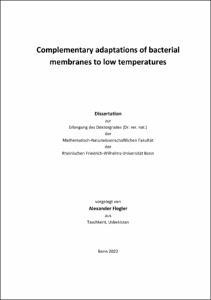Flegler, Alexander: Complementary adaptations of bacterial membranes to low temperatures. - Bonn, 2022. - Dissertation, Rheinische Friedrich-Wilhelms-Universität Bonn.
Online-Ausgabe in bonndoc: https://nbn-resolving.org/urn:nbn:de:hbz:5-67089
Online-Ausgabe in bonndoc: https://nbn-resolving.org/urn:nbn:de:hbz:5-67089
@phdthesis{handle:20.500.11811/10209,
urn: https://nbn-resolving.org/urn:nbn:de:hbz:5-67089,
author = {{Alexander Flegler}},
title = {Complementary adaptations of bacterial membranes to low temperatures},
school = {Rheinische Friedrich-Wilhelms-Universität Bonn},
year = 2022,
month = aug,
note = {The membrane of bacteria is a crucial component that separates the cell from its environment and forms the site of essential functions such as energy generation, nutrient uptake, and sensing. Some bacteria can adapt their membrane to low temperatures by changing the endogenous fatty acid composition to maintain the biologically active liquid-crystalline phase and prevent the transition to the gel phase.
Food preservation by cold storage is indispensable to ensure food stability and safety. However, some food-associated bacteria like the zoonotic pathogen Listeria monocytogenes can survive and grow despite low temperatures by adjusting their fatty acid composition via de novo biosynthesis. Furthermore, some strains of this species can adapt by an additional, fatty acid-independent mechanism by increasing menaquinone content. Other food-associated bacteria are also thought to adapt to low temperatures by using fatty acid-independent mechanisms and incorporating synthesized carotenoids into their membrane. Therefore, in the present work, in addition to the de novo synthesis of fatty acids, the effects of exogenous fatty acids from the food matrix and endogenously produced menaquinones on Listeria monocytogenes and of endogenously produced carotenoids from food-associated pigmented bacteria were investigated as cold adaptation mechanisms.
Various supplementation and inhibition experiments, both chemical and molecular, verified the effect of the investigated bacterial membranes' fatty acid-dependent and -independent adaptation to low temperatures. Thus, Listeria monocytogenes incorporated exogenous fatty acids into its membrane to maintain membrane fluidization at low temperatures, revealing an unknown mechanism in this pathogen. Furthermore, the menaquinone-dependent membrane fluidization disruption resulted in lower resistance to temperature stress and lower growth rates of Listeria monocytogenes. The increased level of the rare C50 carotenoid bacterioruberin in the newly discovered food-associated bacterium Arthrobacter bussei and its closest relative Arthrobacter agilis was confirmed as a fatty acid-independent cold adaptation mechanism. In addition to chemical inhibition experiments, genetic manipulation, creating an adapted CRISPR/Cas system for Arthrobacter species, was used as an alternative to studying the effects of the carotenoid. Hence, the present dissertation provides new insights into the cold adaptation mechanisms in human pathogens and novel food-associated bacteria, which sheds light on a little-explored research field and should be considered for future modeling of food stability and objective against bacterial colonization.},
url = {https://hdl.handle.net/20.500.11811/10209}
}
urn: https://nbn-resolving.org/urn:nbn:de:hbz:5-67089,
author = {{Alexander Flegler}},
title = {Complementary adaptations of bacterial membranes to low temperatures},
school = {Rheinische Friedrich-Wilhelms-Universität Bonn},
year = 2022,
month = aug,
note = {The membrane of bacteria is a crucial component that separates the cell from its environment and forms the site of essential functions such as energy generation, nutrient uptake, and sensing. Some bacteria can adapt their membrane to low temperatures by changing the endogenous fatty acid composition to maintain the biologically active liquid-crystalline phase and prevent the transition to the gel phase.
Food preservation by cold storage is indispensable to ensure food stability and safety. However, some food-associated bacteria like the zoonotic pathogen Listeria monocytogenes can survive and grow despite low temperatures by adjusting their fatty acid composition via de novo biosynthesis. Furthermore, some strains of this species can adapt by an additional, fatty acid-independent mechanism by increasing menaquinone content. Other food-associated bacteria are also thought to adapt to low temperatures by using fatty acid-independent mechanisms and incorporating synthesized carotenoids into their membrane. Therefore, in the present work, in addition to the de novo synthesis of fatty acids, the effects of exogenous fatty acids from the food matrix and endogenously produced menaquinones on Listeria monocytogenes and of endogenously produced carotenoids from food-associated pigmented bacteria were investigated as cold adaptation mechanisms.
Various supplementation and inhibition experiments, both chemical and molecular, verified the effect of the investigated bacterial membranes' fatty acid-dependent and -independent adaptation to low temperatures. Thus, Listeria monocytogenes incorporated exogenous fatty acids into its membrane to maintain membrane fluidization at low temperatures, revealing an unknown mechanism in this pathogen. Furthermore, the menaquinone-dependent membrane fluidization disruption resulted in lower resistance to temperature stress and lower growth rates of Listeria monocytogenes. The increased level of the rare C50 carotenoid bacterioruberin in the newly discovered food-associated bacterium Arthrobacter bussei and its closest relative Arthrobacter agilis was confirmed as a fatty acid-independent cold adaptation mechanism. In addition to chemical inhibition experiments, genetic manipulation, creating an adapted CRISPR/Cas system for Arthrobacter species, was used as an alternative to studying the effects of the carotenoid. Hence, the present dissertation provides new insights into the cold adaptation mechanisms in human pathogens and novel food-associated bacteria, which sheds light on a little-explored research field and should be considered for future modeling of food stability and objective against bacterial colonization.},
url = {https://hdl.handle.net/20.500.11811/10209}
}






